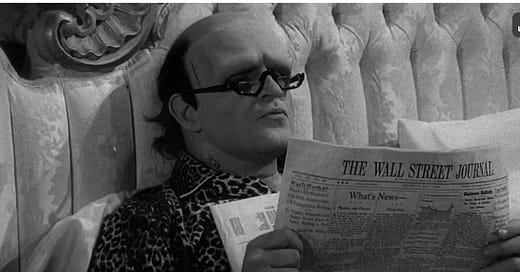Dr. Frankenstein would like a word. What have you done to his monster?
The market index as a struggle between the Enlightenment and Romanticism.
In recent weeks, the “market” has sold off. That’s gotten the attention of many investors, but for me it also begs a simple question: what is “the market”? Yes, that’s a serious question. The most common answer is the S&P 500 Index (SP5) companies and their market-cap weighted price index.**
But if you step back and think a bit more about the question, you can find yourself lost in a story of progress gone wrong. Recall that SP5 was created in 1957 (based on several prior versions dating back to 1926) to give investors and the media a way to track and analyze price changes of the US stock market on a daily basis. It was what it purported to be: a simple (market cap-weighted) index of stock prices. The SP5 allowed an answer to the question of how the market was doing based on the price of its constituents: Up, down, sideways, thank you, and goodbye. It was nothing less, and nothing more. SP5 was designed and initially served as a reasonably transparent reflection of the reality of the US stock market. Fast-forward nearly 70 years, and SP5 has become a Frankenstein’s monster. No longer a mere measurement of security prices, it has taken on a life of its own, and changed the whole nature of the market.
First, SP5 has come to have its own crowd-sourced future. Over the decades, market participants, especially sell-side strategists, started forecasting its forward earnings, this year, next year, several years out. The thing is, only a few of those strategists have the ability or inclination to forecast index earnings based on estimates for its 500 constituent elements. That’s data-heavy, complicated, and time-consuming. Instead, those forecasts are based on an expectation vis a vis the prior year’s actual number (which is calculated on the real-world results of the constituent companies). For out-year estimates, it is more commonly just a finger-in-the-air exercise. That is, the forecasts are distinct from the outlook of the underlying companies. They may be directionally parallel, but they are analytically separate.
Second, those forward earnings expectations are then used to figure out the market’s P/E ratio, its basic valuation metric. Assigning the market a P/E number might be akin to Dr. Frankenstein throwing the switch and giving the monster life. If it has a P/E, it breathes. It can be cheap, it can be expensive, it can be fairly priced. It has a character. (That character is not exactly transparent. The forward estimates are for “operating earnings”—after all the bad stuff is taken out. Reported actual earnings are historically about 10% lower than those operating earnings. That is, P/Es are regularly understated.) As a result of these earnings estimates and the application of P/E ratios, the market also has hopes and dreams. They are called “price targets.” Market strategists spend a lot of time on SP5 price targets in an exercise that is, once again, mostly removed from the current valuation or future prospects of its underlying components.
Third, within just a few decades of its creation, the SP5 idea took on corporeal form as an index fund, and more recently index ETFs. These are real securities, not just a measure of real securities. These wildly popular products now hold roughly ¼ of the SP5’s market capitalization of $50 trillion. Think about that. The SP5 no longer helpfully reflects the state of the market; it is a self-standing $12 trillion investment. King Kong and Godzilla are, by comparison, puny compared to this monster. Even market leaders Microsoft and Apple, each with a $3 trillion market cap, are only a quarter the size of SP5. (Yes, I know, one is a subset of the other….)
Derivatives on the SP5 make the investment even larger. The word “derivative” often scares Main Street investors (and delights Wall Street traders and hedge funds), but it is fair to say that your supposedly plain vanilla, passive, efficient-market SP5 index fund or ETF is, in fact, a derivative, in that it is derived from something else. The universe of available SP5 call and put options are all therefore exercises in second derivatives. The notional value of those options is also in the trillions. The number changes day-to-day, but it is big.
Fourth, as a youngster, the monster was pliant, keeping to its original mission of measuring the market, not moving it. No longer. At its current size, our gangly teenager bumps heavily into the furniture as it moves through our portfolios. It is so large that inclusions and exclusions lead to huge share price swings in the affected securities. And it’s so large that it has to make and break its own rules about inclusion or exclusion to get the latest hot-stocks into the index. And when there are flows into and out of the SP5 index products—billions everyday—those securities buy and sell the constituent stocks, without regard to valuation, without regard to dividends, without regard to anything. SP5 left passive investing long ago. It’s a momentum product, buying what’s going up, and selling what’s going down. And in doing so, it accentuates those very trends. There’s nothing at all wrong with momentum investing as a conscious choice by the investor. But calling a momentum product passive, and thereby suggesting it is somehow less risky, is another matter altogether. So long genuine price discovery; who needed you anyway.
Fifth, Dr. Frankenstein has reason to be proud. Not only is his creation large, it is also well educated. The monster went to university, joined the finance club, and became the basis for the Capital Asset Pricing model. This tool to price assets dates from the mid-1960s, about a decade after the index’s creation. (SP5 is nothing if not precocious). The CAPM replaced horrendous covariance tables with a simple measure of sensitivity—popularly known as beta—to the overall market, usually rendered by the SP5. Beta is a way to give a modest amount of character to each stock in the SP5. Well, in the upside-down world in which we now live, that formula has been reversed. For the past several years, the market appears to have had a high sensitivity to the handful of securities, the Mag7. They are not sensitive to market movements; the market is sensitive to their movements. It’s a typical sort of passive-aggressive behavior from the monster.
Sixth, while we are getting into questions of character, it’s fair to note that many market observers the past few years have criticized the “financialization” of the stock market. This term of abuse can mean whatever the critic wants it to mean, but in general, it can be summarized as developments and products in the stock market that have led to financial returns far greater than the economic growth of the underlying business assets or the economy overall. (Think an investment in Coke grows much faster than Coke itself. That cannot go on forever.)
I’ll dodge the political side of the financialization debate. but I will chime in that Frankenstein’s SP5 monster couldn’t be a better example of the divorce between transparent and direct business ownership through the stock market, on one hand, and a Wall Street creation. What started as a tool for measuring real business ownership through the stock market has become something else altogether. I’ve written a series of books in support of business ownership through the stock market. But those books have fallen mostly on deaf ears—except for a dedicated coterie of readers. The vast majority of investors seem quite content with the evolution of Dr. Frankenstein’s creature. Indeed, they see no monster at all. In particular, the academics have welcomed the diversification benefit of SP5. I counter here that SP5 no longer just reflects the broader market, and therefore no longer delivers on the diversification promise. Instead, it is its own unique take on the market. (To be fair, they also like that the monster is cheap; and that it is.)
So where are we? Well, when Dr. Frankenstein’s experiment to conquer nature becomes Peter Boyle reading the WSJ in bed in a Mel Brooks movie, investors need to pay attention and think seriously about what they are getting, and what they are losing, for their 5 basis points. Recall that Mary Shelley’s original story was a cautionary tale about Enlightenment hubris. Its subtitle, The Modern Prometheus, should remind investors that there is a price to pay for their presumption that SP5 solves the challenge of investment decision making under conditions of uncertainty.
End of Part 1
Comments welcome.
** The views expressed are those of the author alone, not those of his employer or any other individual. Not investment advice. Consult your financial advisor before making any investment decision.
(Boyle image courtesy 20th Century Fox)





super piece. the plumbing is a mess and the risk of a pipe failing is misjudged. i had not really thought through how important the measurement vs vehicle distinction really is.
This post reminds me of Bertram Russell’s example of the composition logical fallacy: "every man who exists has a mother, therefore the entire human race has a mother." Looking forward to the next part and also wondering if you are working on another book.